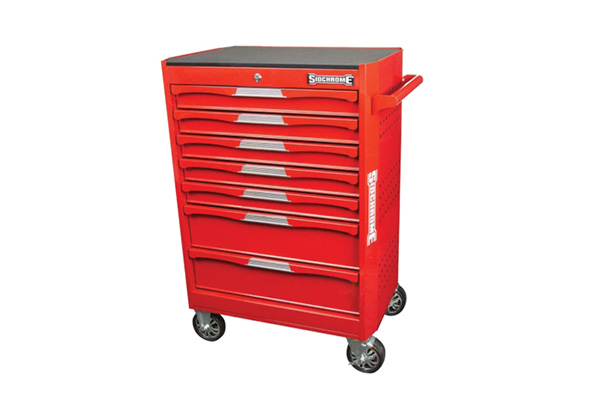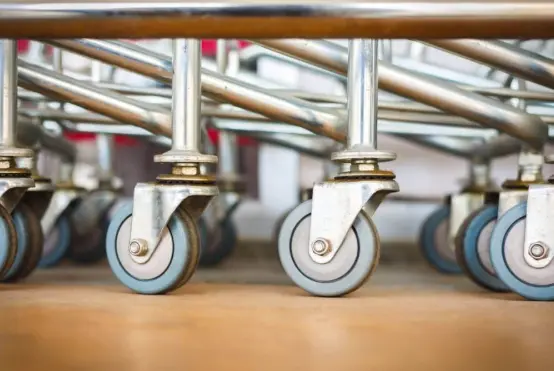Hi, I'm Allen. For over 20 years, my factory has been the engine behind thousands of high-quality tool trolleys, cabinets, and service carts used in workshops across the USA and Europe. I've had countless conversations with discerning B2B buyers like Mark Thompson, who need to source equipment that is both durable and cost-effective. And through all those conversations, one component always comes up as a make-or-break feature: the caster. A great cart with a bad caster wheel is just a heavy, stationary box. The right casters, on the other hand, transform it into an efficient, mobile workstation. This guide is a deep dive into the world of caster wheels. I'll share my factory-floor knowledge to help you understand every aspect of choosing the perfect caster for any application, ensuring you get a product that will glide smoothly and last for years.
What Exactly is a Caster, and Why is it More Than Just a Wheel?
Many people use the terms "wheel" and "caster" interchangeably, but they are not the same thing. A wheel is simply the round part that rolls. A caster is the entire assembly that includes the wheel, the frame (or yoke) that holds the wheel, and the mounting mechanism that attaches it to the bottom of a cart or cabinet. Think of it this way: the wheel is the tire, but the caster is the entire wheel assembly, including the axle and the part that connects it to the car. This distinction is critical because the quality of the frame and the smoothness of the pivot mechanism are just as important as the wheel itself for performance.
In our factory, when we design a new tool cart, the caster selection is a major engineering decision. A cheap caster might use a flimsy, stamped metal frame that bends under a heavy load. A high-quality caster, however, will feature a robust, often forged steel yoke that can handle significant stress. The performance of the entire cart hinges on this complete assembly. A good caster ensures a smooth ride, easy steering, and long-term reliability. A bad caster leads to frustration, inefficiency, and can even be a safety hazard if it fails.
Swivel vs. Rigid: Which Caster is Right for Your Cart?
Casters come in two primary types: swivel and rigid. A swivel caster is mounted on a pivot, allowing the wheel to rotate a full 360-degree circle. This gives you the ability to steer the cart in any direction and navigate tight spaces and around corners. A rigid caster, also known as a fixed caster, is locked in a fixed position. It can only roll forward and backward in a straight line. A rigid caster does not turn sideways.
The best setup for most carts, including service carts and tool trolleys, is a combination of both. The most common configuration is two swivel casters at the front (the end you push) and two rigid casters at the back. This provides an ideal balance of maneuverability and control. The swivel casters allow you to steer, while the rigid caster set keeps the cart tracking straight and prevents the back end from fishtailing. For a smaller dolly or a cart that needs to move in all directions within a very confined space, using four swivel caster units can be beneficial. However, for moving a heavy load across a warehouse floor, the two-and-two combination is the industry standard.
| Caster Type | Pros | Cons | Best Use Case |
|---|---|---|---|
| Swivel Caster | Highly maneuverable, turns in tight spaces | Can be harder to control in a straight line | Front of a cart, office chairs, dollies |
| Rigid Caster | Excellent for straight-line travel, adds stability | Cannot steer or turn | Back of a cart, equipment meant to move forward/backward |
How Does Wheel Diameter Affect How Smoothly Your Cart Can Glide?
The size of the wheel itself, specifically its diameter, has a huge impact on how easily your cart moves. It’s a simple matter of physics: a larger wheel diameter results in a smoother ride. A bigger wheel can more easily roll over cracks, cords, and small debris on the floor without getting stuck. Think about trying to push a shopping cart with tiny wheels across a gravel parking lot—it's a struggle! A larger wheel would handle that uneven surface much better.
This is why we always advise clients to consider the environment where the cart will be used. For a pristine, smooth epoxy floor in a high-tech workshop, a smaller 3-inch caster wheel might be fine. But for a typical garage, a construction site, or an older factory with rough concrete, a 5-inch or even 6-inch wheel is a much better choice. The larger wheel lowers the rolling resistance, meaning you have to exert less force to get the cart moving and keep it rolling. It makes a heavy cart feel significantly lighter to push.

What's the Best Wheel Material for Your Caster? A Durable Guide.
The material of the wheel tread is another critical factor that determines the performance of your caster. There is no single "best" material; the right choice depends on the floor surface, the load weight, and the need for noise reduction. A hard wheel, for example, is easier to roll but can be noisy and may damage delicate floors. A softer wheel is quieter and protects floors but has a higher rolling resistance.
Here are some of the most common wheel materials we work with:
- Polyurethane: This is one of the most versatile and popular choices. A polyurethane wheel offers a great compromise. It's durable, non-marking, resistant to chemicals, and provides a quieter, cushioned ride compared to steel or phenolic. Polyurethane casters are an excellent all-around option for workshops and garages.
- Rubber (Hard or Soft): A soft rubber tire provides the best floor protection, shock absorption, and quietest operation. However, it can develop a flat spot if left stationary under a heavy load for too long. Hard rubber is more durable and has a higher weight capacity.
- Steel or Cast Iron: For extremely heavy loads and maximum durability on rough surfaces, nothing beats a steel caster or cast iron wheel. These are virtually indestructible but are very noisy and can damage floors. They are best suited for industrial settings with concrete floors.
- Polyolefin: This is a hard, lightweight plastic that is resistant to water and chemicals. A polyolefin caster wheel is an economical choice for wet environments, but it can be noisy on rough surfaces.
How Do You Calculate the Correct Weight Rating for Heavy-Duty Casters?
One of the most dangerous mistakes you can make is underestimating the weight rating needed for your casters. A failed caster on a heavily loaded cart can cause property damage and serious injury. The weight capacity of a caster (often called the load rating) is the maximum weight that a single caster wheel can safely support. To calculate the total capacity you need, you must determine the total weight of the cart plus its heaviest potential load, and then divide it by the number of casters you will use, minus one.
Why minus one? You must account for the possibility of the cart rolling over an uneven surface, like a slope or a bump, where one caster might temporarily lift off the ground. In that scenario, the entire load is distributed among the remaining three casters.
Formula: (Weight of Cart + Max Weight of Contents) / 3 = Required Rating Per Caster
For example, if your cart weighs 100 lbs and you plan to haul up to 500 lbs of tools and equipment, your total load is 600 lbs.
600 lbs / 3 = 200 lbs.
You would need to choose four casters each with a weight rating of at least 200 lbs. For any heavy-duty application, it’s always wise to choose a caster with a higher rating than you calculate to provide a safety margin.

Why are Bearings the Unsung Heroes of a Smooth-Rolling Caster Wheel?
The bearing is the hidden component inside the hub of the wheel and in the swivel mechanism of the caster that allows it to roll and turn smoothly. The quality of the bearing directly impacts the rolling resistance of the caster. A cart with high-quality bearings will feel effortless to push, while one with cheap bearings will feel gritty and require much more force. This is a detail that separates premium brands like Snap-on or Craftsman from generic alternatives.
There are several types of bearings, but for most workshop applications, ball bearings are the gold standard. Precision ball bearings provide the smoothest and easiest roll, making them ideal for carts that are moved frequently or carry heavier loads. A less expensive option is a sleeve or plain bore bearing, which is simply the axle rubbing against the inside of the wheel hub. While functional for very light duties, it has much higher friction. When we build a heavy-duty cart, we always use high-quality ball bearings in both the wheel and the swivel raceway to ensure a long life and a smooth glide across the floor.
Understanding Caster Mounting Options: Plate vs. Stem
How a caster attaches to your cart is another important consideration. The two most common mounting types are plate and stem. Plate-mount casters have a flat, square, or rectangular plate at the top with four bolt holes. This plate is bolted directly to the underside of the cart, providing a very strong and stable connection. This is the standard for nearly all tool carts, workbenches, and industrial equipment because it distributes the load over a larger surface area. You simply line up the mounting plates with the pre-drilled holes on the cabinet and secure them with a bolt and nut.
Stem casters, on the other hand, use a single metal stem that is inserted into a hole or socket on the equipment. You often see stem casters on office chairs, medical equipment, and light-duty service carts. While they are easier to install and replace, they generally have lower load ratings than plate casters. For any application involving significant weight, plate-mount casters are the superior and safer choice.
Do You Really Need a Caster with a Lock?
Yes, you almost certainly do. A caster with a lock is a critical safety feature. A lock prevents the wheel from rolling, ensuring your cart will stay put when you need it to. Imagine working on a slight slope in a driveway; without a lock, your expensive tool chest could start rolling away. A caster lock is essential for preventing accidents and ensuring stability while you are working.
There are different types of locking features. The most common type is a simple pedal or lever that presses against the tire tread, preventing the wheel from turning. A more advanced and secure option is a total lock caster. This type of lock not only stops the wheel from rolling but also locks the swivel mechanism, preventing the caster from turning. This makes the cart completely stationary, which is ideal when you're using the top surface as a workbench. For safety and convenience, we always recommend that at least the two swivel caster units on a cart are locking casters.
How to Maintain Your Caster Wheels to Make Them Last Longer
High-quality casters are perfect for years of service, but like any mechanical part, they benefit from a little maintenance. Proper care will ensure your casters last longer and continue to roll smoothly. The most important maintenance task is to periodically clean the caster wheel and axle. Hair, string, and other debris can get wrapped around the axle, increasing rolling resistance and eventually causing the wheel to seize up.
It's also a good practice to inspect the caster for wear and tear. Check the wheel tread for flat spots or damage and ensure the mounting bolts are tight. For casters that have a grease fitting (zerk fitting), applying a small amount of new grease every six months will keep the bearings and swivel raceway lubricated and functioning perfectly. This simple five-minute check can dramatically extend the life of your caster and keep your cart rolling like new.

A Final Checklist: Your Comprehensive Guide to Selecting the Perfect Caster
Choosing the right casters can feel overwhelming, but it doesn't have to be. By systematically considering each key feature, you can confidently select the perfect caster for your needs. Whether you are buying a fully assembled mobile tool cart or purchasing new casters to upgrade an old piece of equipment like a tool cabinet, this is your final checklist.
Use this comprehensive guide before making a decision:
- Application: Where and how will the cart be used? (e.g., smooth workshop floor, rough garage, etc.)
- Load Capacity: Have you calculated the required weight rating per caster using the "divide by 3" rule?
- Mobility Needs: Do you need maximum maneuverability (four swivel casters) or a balance of steering and stability (two swivel, two rigid)?
- Wheel Size: Is the wheel diameter large enough to handle the floor conditions?
- Wheel Material: Does the wheel material match your needs for floor protection, noise level, and durability? (e.g., Polyurethane, Rubber, Steel)
- Bearings: Does the caster use high-quality ball bearings for a smooth roll?
- Locking: Do at least two of your casters have a reliable lock?
Key Takeaways
The casters are the single most important component for determining the mobility and usability of your cart. A thoughtful choice can make your work easier, safer, and more efficient for years.
- A Caster is an Assembly: Remember that a caster includes the wheel, frame, and mount. All parts must be high quality.
- Calculate Your Load Correctly: Always use the formula (Total Weight / 3) to determine the required rating for each caster to ensure safety.
- Match the Wheel to the Floor: The wheel material and diameter are critical. Larger, softer wheels are better for rough or delicate surfaces.
- Swivel & Rigid Combo is Best: For most carts, two swivel casters and two rigid casters provide the perfect blend of steering and stability.
- Locks and Bearings Matter: Don't overlook these features. Ball bearings ensure a smooth roll, and a good lock is an essential safety feature to keep your cart from rolling away. Whether it's a simple trolley or a heavy-duty chest, the right casters make all the difference.
Post time: 11-12-2025



